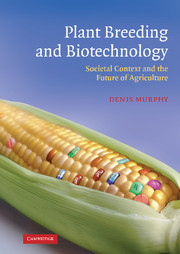Book contents
- Frontmatter
- Contents
- Preface
- Acknowledgements
- Using this book
- Nomenclature and terminology
- Abbreviations and glossary
- Introduction
- Part I The science of plant breeding
- Part II The societal context of plant breeding
- Part III Turmoil and transition: the legacy of the 1980s
- Part IV The agbiotech paradigm
- Part V Increasing global crop production: the new challenges
- 14 Feeding the world – fallacies and realities
- 15 The roles of management, subsidies and breeding in crop improvement
- Part VI Plant breeding in the twenty-first century
- Notes
- References
- Index
14 - Feeding the world – fallacies and realities
Published online by Cambridge University Press: 07 May 2010
- Frontmatter
- Contents
- Preface
- Acknowledgements
- Using this book
- Nomenclature and terminology
- Abbreviations and glossary
- Introduction
- Part I The science of plant breeding
- Part II The societal context of plant breeding
- Part III Turmoil and transition: the legacy of the 1980s
- Part IV The agbiotech paradigm
- Part V Increasing global crop production: the new challenges
- 14 Feeding the world – fallacies and realities
- 15 The roles of management, subsidies and breeding in crop improvement
- Part VI Plant breeding in the twenty-first century
- Notes
- References
- Index
Summary
I will venture to affirm, that the three seasons wherein our corn has miscarried did no more contribute to our present misery, than one spoonful of water thrown upon a rat already drowned would contribute to his death; and that the present plentiful harvest, although it should be followed by a dozen ensuing, would no more restore us, than it would the rat aforesaid to put him near the fire, which might indeed warm his fur-coat, but never bring him back to life.
Jonathan Swift (1667–1745) FamineIntroduction
It is frequently opined in the popular and scienctific media alike that crop production may have serious difficulties in coping with projected increases in the global human population over the next fifty years. It has also become commonplace to hear statements, from biotech companies, politicians and even some public sector scientists, that this putative crisis in food production can only be fully resolved by the global deployment of transgenic crops. Of course, over the past few centuries, we have repeatedly heard various Malthusian predictions about imminent famine, all of which have proven to be misplaced. As we saw in Chapter 4, it was forecasts of future famine that prompted the USDA to begin its programme of worldwide germplasm collections in the late nineteenth century. The spectre of overpopulation was a recurring theme during the twentieth century, but the most egregious instances of misguided predictions of imminent apocalypse occurred in the late 1960s and early 1970s.
- Type
- Chapter
- Information
- Plant Breeding and BiotechnologySocietal Context and the Future of Agriculture, pp. 213 - 225Publisher: Cambridge University PressPrint publication year: 2007



